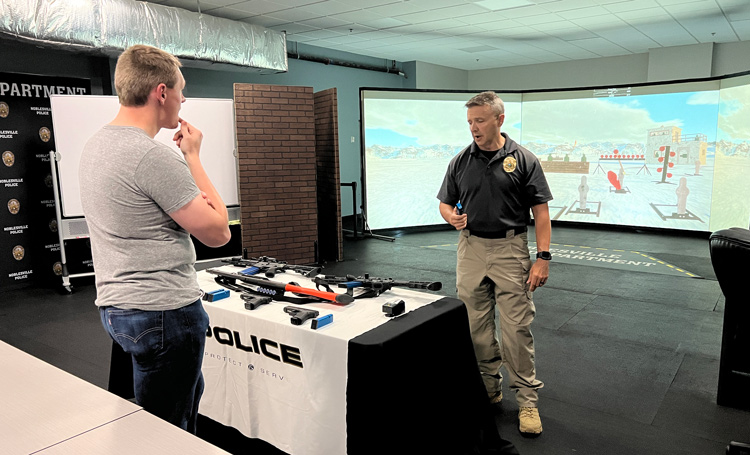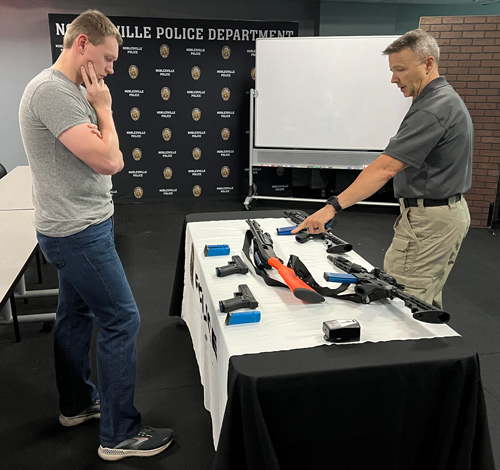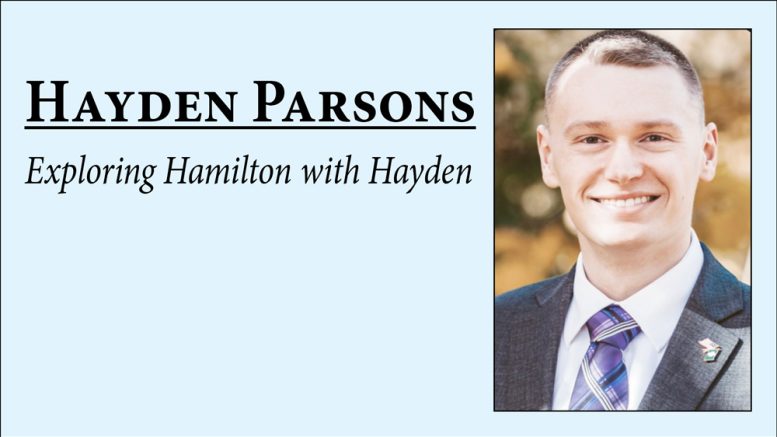You’re driving down the road when suddenly you get a call to investigate a potential theft. The would-be-thief is still at the scene and is “acting strange.” You arrive … now what do you do?
This exact scenario was one that I was able to experience first-hand thanks to an opportunity to learn about the VirTra training system owned by the Noblesville Police Department (NPD). The equipment uses real firearms loaded with magazines filled with carbon dioxide to simulate recoil and lasers mounted into the barrels that detect shot placement. This allows NPD, and other police departments who train on the system, to practice firearms training nearly risk-free on a virtual firing range.
But the shining star of the system is the simulations.
The system envelopes the trainee in a closed reality where the trainer can dictate how the people in the simulation react. It reminded me of a “choose your own adventure” storybook, except you are the one living it. Your actions have consequences – for better or for worse.

Hayden Parsons (left) listens to Sgt. Corey Everhart of NPD’s Professional Standards Division explain the technology and end benefits of the VirTra system. (Reporter photo by Stu Clampitt)
While an expensive roleplay machine can seem silly, the experience is invaluable. It places a new perspective on what police officers go through every day. You don’t know what to expect, but you have to be prepared to expect everything. It can be stressful, but the skills it develops in officers improves safety across the board.
Public servants can easily be dehumanized. They are tools of the government that act on government authority. But the reality is that they are normal people too. Putting myself in their shoes for an hour and having to make the same decisions they make every day is humbling. I’m no one special, but here I am trying to make sure everyone leaves a (simulated) situation safely.
The would-be-thief looked to be a middle school-aged boy. His actions were indeed odd, just as the call said. He was holding a box of candy and was telling me to stay away and to stop getting close to him. Immediately before the scenario, I was able to simulate giving commands to people. However, some of the people would pull out a firearm to shoot me or they would pull out something like a driver’s license instead. It’s nerve racking since you can’t tell what it is until they pull it out. This prompted me to become cautious whenever anyone reached into a pocket or bag.

Reporter photo by Stu Clampitt
The boy began to reach into his pocket. Admittedly, I flinched and instinctively placed my hand to my holstered weapon which I was using for the scenario. But I hesitated to escalate, and the boy pulled out a contact card that stated he had autism and in case of a situation to call his dad. The situation ended positively, with the boy’s dad showing up, the boy paying for his candy with money he had the entire time, and everyone leaving safely.
I was later told by the trainer that had I reacted differently, he could have changed the situation to go south very quickly.
A system like this revolutionizes police training. After having experienced it first hand, my confidence in the safety provided to Hamilton County is high. No one is a perfect citizen or cop. Inevitably, we all will make mistakes. But by dedicating ourselves to improvement to ourselves and our craft, we can avoid catastrophe. The more experiences like the VirTra training that our community has, the better we will all become.
After all, a person is nothing more than the sum of their experiences.
Hayden C. T. Parsons is the newest associate at Adler Attorneys in Noblesville.

